Solution: Statistics and Data Analysis HW Assignment 1
VerifiedAdded on 2023/05/31
|8
|1041
|397
Homework Assignment
AI Summary
This document presents the solutions to Homework Assignment 1 in Statistics and Data Analysis. The assignment covers several key concepts including calculating the number of independent samples needed to achieve a certain probability of finding a defective product, exploring the Poisson distribution and finding its optimal lambda, and analyzing covariance and independence between random variables using provided datasets. The solution includes code implementations, visualizations like histograms, and explanations to illustrate the statistical concepts. The assignment also delves into convolutions and probability distributions, providing a comprehensive understanding of the concepts covered in the course.
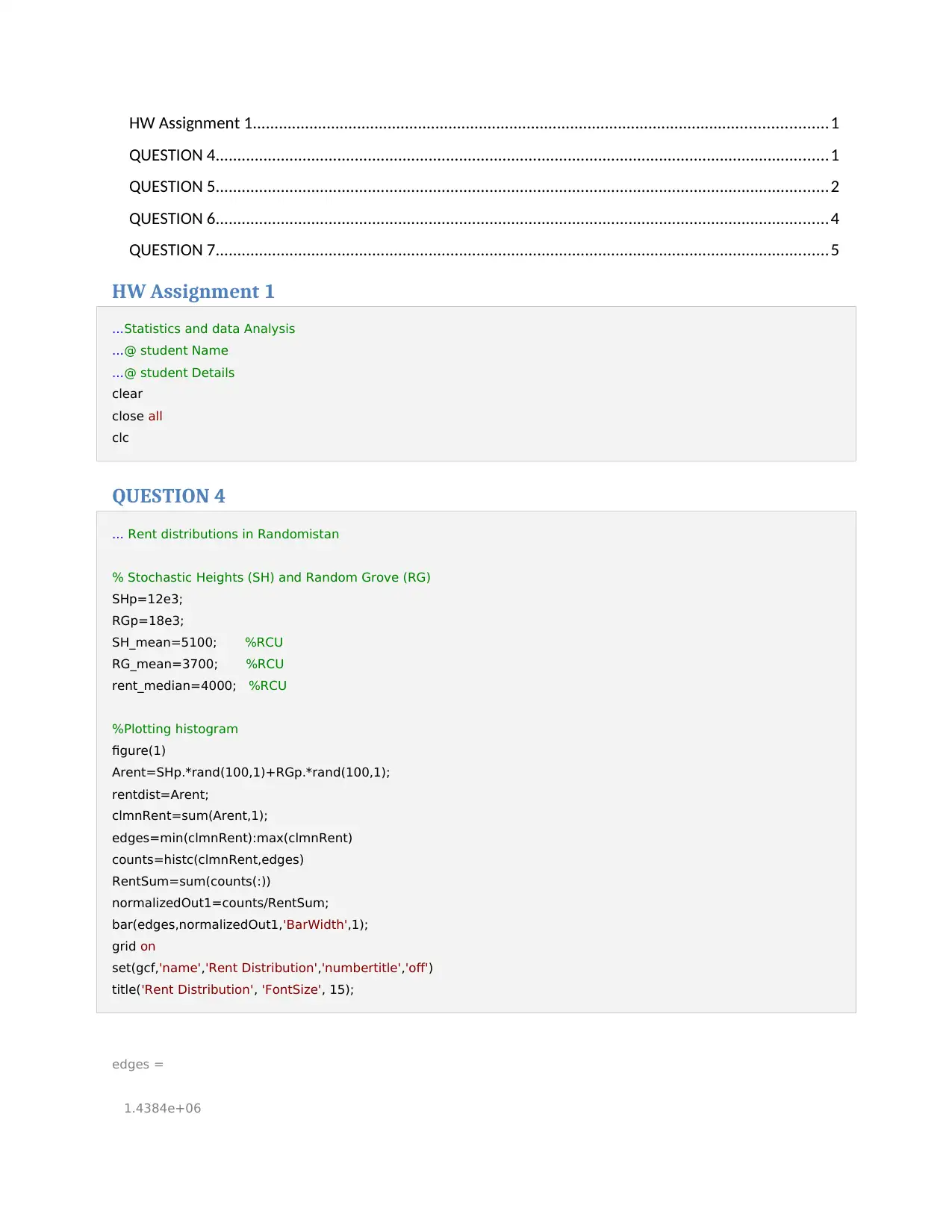
HW Assignment 1....................................................................................................................................1
QUESTION 4.............................................................................................................................................1
QUESTION 5.............................................................................................................................................2
QUESTION 6.............................................................................................................................................4
QUESTION 7.............................................................................................................................................5
HW Assignment 1
...Statistics and data Analysis
...@ student Name
...@ student Details
clear
close all
clc
QUESTION 4
... Rent distributions in Randomistan
% Stochastic Heights (SH) and Random Grove (RG)
SHp=12e3;
RGp=18e3;
SH_mean=5100; %RCU
RG_mean=3700; %RCU
rent_median=4000; %RCU
%Plotting histogram
figure(1)
Arent=SHp.*rand(100,1)+RGp.*rand(100,1);
rentdist=Arent;
clmnRent=sum(Arent,1);
edges=min(clmnRent):max(clmnRent)
counts=histc(clmnRent,edges)
RentSum=sum(counts(:))
normalizedOut1=counts/RentSum;
bar(edges,normalizedOut1,'BarWidth',1);
grid on
set(gcf,'name','Rent Distribution','numbertitle','off')
title('Rent Distribution', 'FontSize', 15);
edges =
1.4384e+06
QUESTION 4.............................................................................................................................................1
QUESTION 5.............................................................................................................................................2
QUESTION 6.............................................................................................................................................4
QUESTION 7.............................................................................................................................................5
HW Assignment 1
...Statistics and data Analysis
...@ student Name
...@ student Details
clear
close all
clc
QUESTION 4
... Rent distributions in Randomistan
% Stochastic Heights (SH) and Random Grove (RG)
SHp=12e3;
RGp=18e3;
SH_mean=5100; %RCU
RG_mean=3700; %RCU
rent_median=4000; %RCU
%Plotting histogram
figure(1)
Arent=SHp.*rand(100,1)+RGp.*rand(100,1);
rentdist=Arent;
clmnRent=sum(Arent,1);
edges=min(clmnRent):max(clmnRent)
counts=histc(clmnRent,edges)
RentSum=sum(counts(:))
normalizedOut1=counts/RentSum;
bar(edges,normalizedOut1,'BarWidth',1);
grid on
set(gcf,'name','Rent Distribution','numbertitle','off')
title('Rent Distribution', 'FontSize', 15);
edges =
1.4384e+06
Paraphrase This Document
Need a fresh take? Get an instant paraphrase of this document with our AI Paraphraser
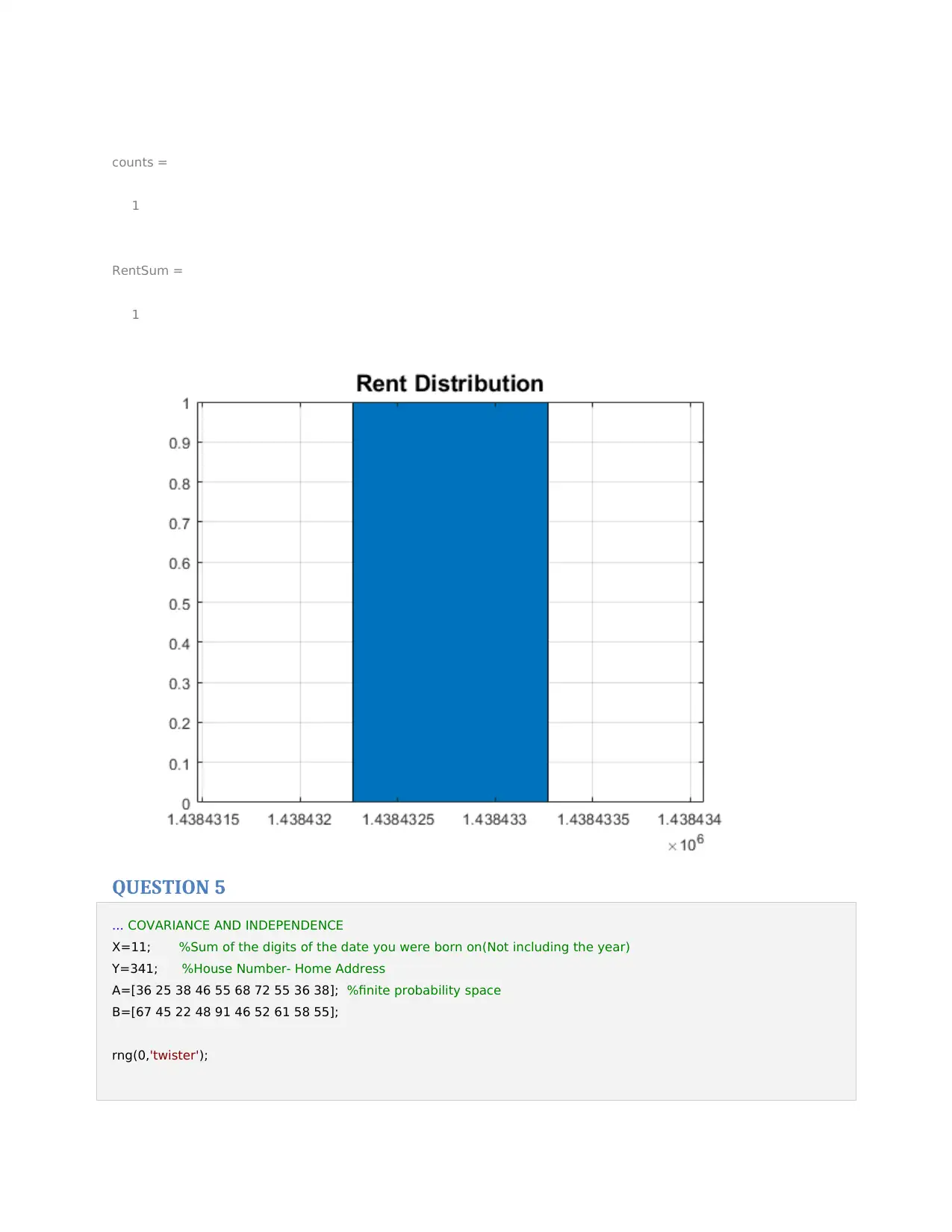
counts =
1
RentSum =
1
QUESTION 5
... COVARIANCE AND INDEPENDENCE
X=11; %Sum of the digits of the date you were born on(Not including the year)
Y=341; %House Number- Home Address
A=[36 25 38 46 55 68 72 55 36 38]; %finite probability space
B=[67 45 22 48 91 46 52 61 58 55];
rng(0,'twister');
1
RentSum =
1
QUESTION 5
... COVARIANCE AND INDEPENDENCE
X=11; %Sum of the digits of the date you were born on(Not including the year)
Y=341; %House Number- Home Address
A=[36 25 38 46 55 68 72 55 36 38]; %finite probability space
B=[67 45 22 48 91 46 52 61 58 55];
rng(0,'twister');
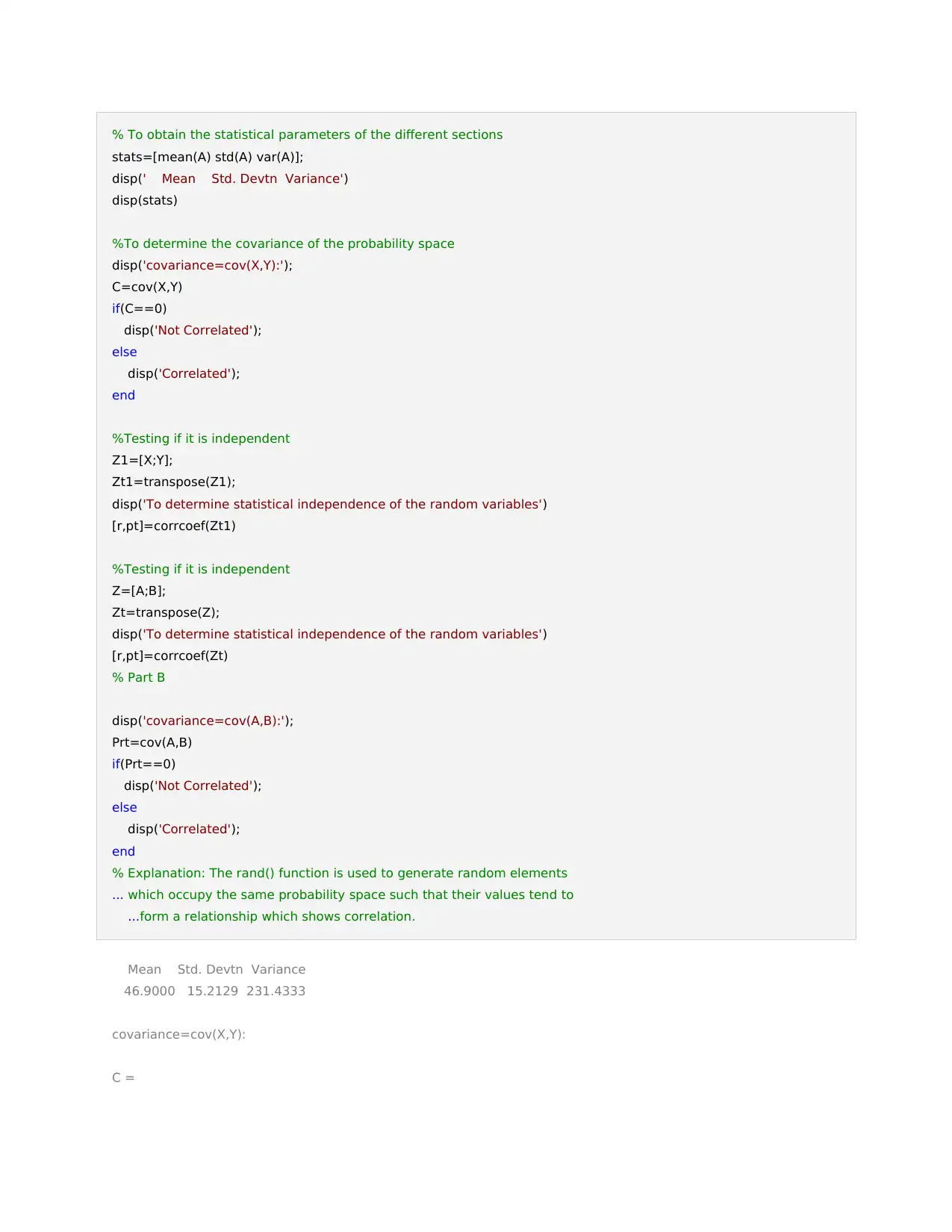
% To obtain the statistical parameters of the different sections
stats=[mean(A) std(A) var(A)];
disp(' Mean Std. Devtn Variance')
disp(stats)
%To determine the covariance of the probability space
disp('covariance=cov(X,Y):');
C=cov(X,Y)
if(C==0)
disp('Not Correlated');
else
disp('Correlated');
end
%Testing if it is independent
Z1=[X;Y];
Zt1=transpose(Z1);
disp('To determine statistical independence of the random variables')
[r,pt]=corrcoef(Zt1)
%Testing if it is independent
Z=[A;B];
Zt=transpose(Z);
disp('To determine statistical independence of the random variables')
[r,pt]=corrcoef(Zt)
% Part B
disp('covariance=cov(A,B):');
Prt=cov(A,B)
if(Prt==0)
disp('Not Correlated');
else
disp('Correlated');
end
% Explanation: The rand() function is used to generate random elements
... which occupy the same probability space such that their values tend to
...form a relationship which shows correlation.
Mean Std. Devtn Variance
46.9000 15.2129 231.4333
covariance=cov(X,Y):
C =
stats=[mean(A) std(A) var(A)];
disp(' Mean Std. Devtn Variance')
disp(stats)
%To determine the covariance of the probability space
disp('covariance=cov(X,Y):');
C=cov(X,Y)
if(C==0)
disp('Not Correlated');
else
disp('Correlated');
end
%Testing if it is independent
Z1=[X;Y];
Zt1=transpose(Z1);
disp('To determine statistical independence of the random variables')
[r,pt]=corrcoef(Zt1)
%Testing if it is independent
Z=[A;B];
Zt=transpose(Z);
disp('To determine statistical independence of the random variables')
[r,pt]=corrcoef(Zt)
% Part B
disp('covariance=cov(A,B):');
Prt=cov(A,B)
if(Prt==0)
disp('Not Correlated');
else
disp('Correlated');
end
% Explanation: The rand() function is used to generate random elements
... which occupy the same probability space such that their values tend to
...form a relationship which shows correlation.
Mean Std. Devtn Variance
46.9000 15.2129 231.4333
covariance=cov(X,Y):
C =
⊘ This is a preview!⊘
Do you want full access?
Subscribe today to unlock all pages.

Trusted by 1+ million students worldwide
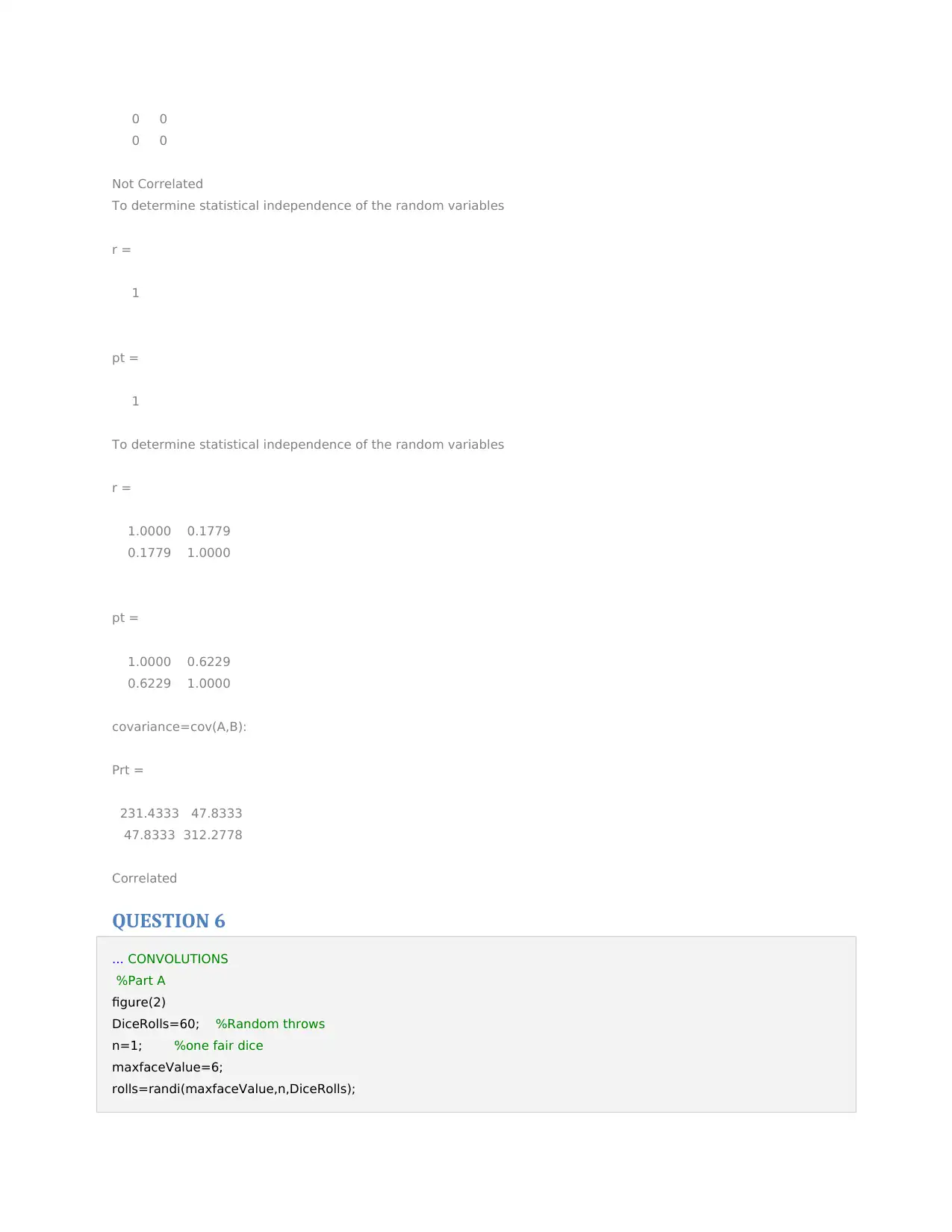
0 0
0 0
Not Correlated
To determine statistical independence of the random variables
r =
1
pt =
1
To determine statistical independence of the random variables
r =
1.0000 0.1779
0.1779 1.0000
pt =
1.0000 0.6229
0.6229 1.0000
covariance=cov(A,B):
Prt =
231.4333 47.8333
47.8333 312.2778
Correlated
QUESTION 6
... CONVOLUTIONS
%Part A
figure(2)
DiceRolls=60; %Random throws
n=1; %one fair dice
maxfaceValue=6;
rolls=randi(maxfaceValue,n,DiceRolls);
0 0
Not Correlated
To determine statistical independence of the random variables
r =
1
pt =
1
To determine statistical independence of the random variables
r =
1.0000 0.1779
0.1779 1.0000
pt =
1.0000 0.6229
0.6229 1.0000
covariance=cov(A,B):
Prt =
231.4333 47.8333
47.8333 312.2778
Correlated
QUESTION 6
... CONVOLUTIONS
%Part A
figure(2)
DiceRolls=60; %Random throws
n=1; %one fair dice
maxfaceValue=6;
rolls=randi(maxfaceValue,n,DiceRolls);
Paraphrase This Document
Need a fresh take? Get an instant paraphrase of this document with our AI Paraphraser
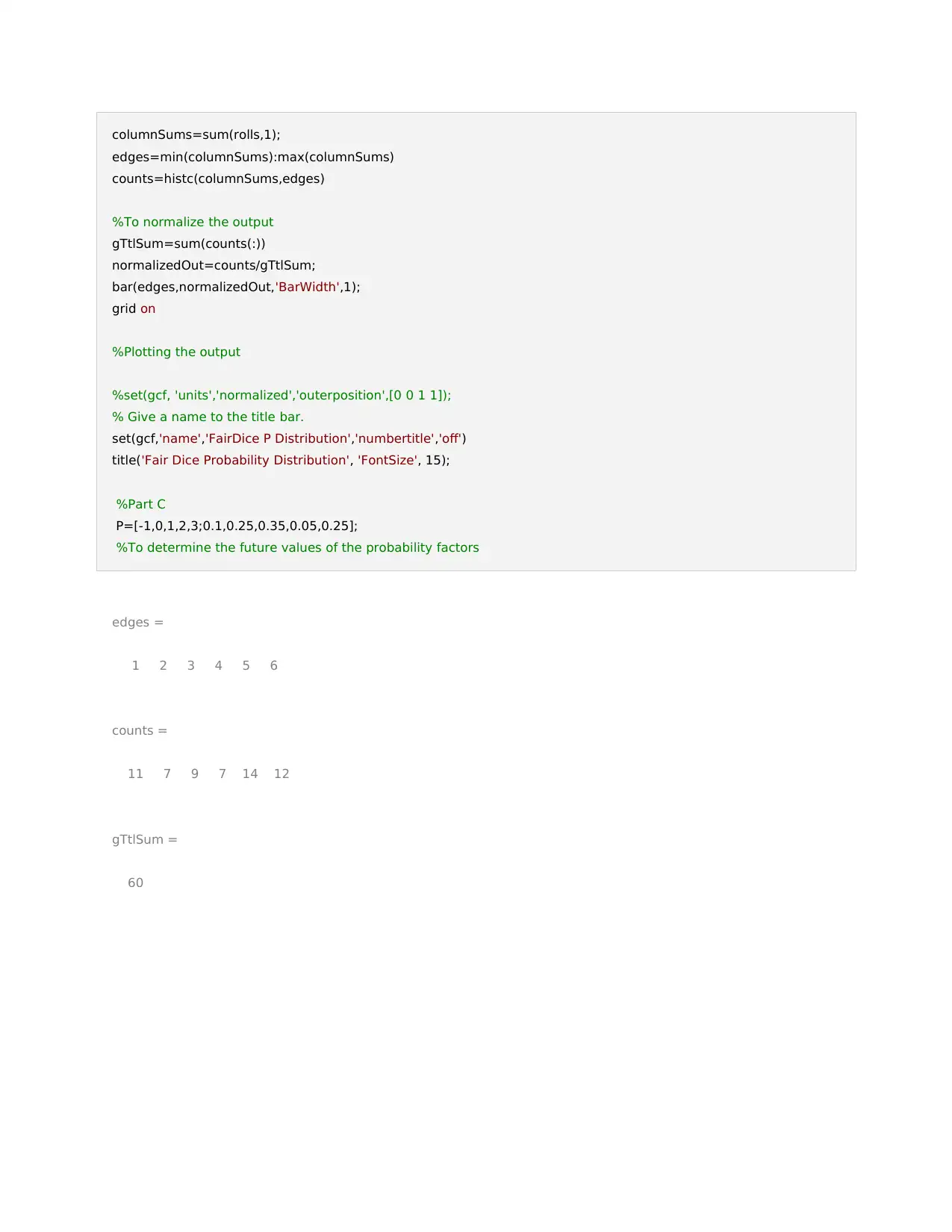
columnSums=sum(rolls,1);
edges=min(columnSums):max(columnSums)
counts=histc(columnSums,edges)
%To normalize the output
gTtlSum=sum(counts(:))
normalizedOut=counts/gTtlSum;
bar(edges,normalizedOut,'BarWidth',1);
grid on
%Plotting the output
%set(gcf, 'units','normalized','outerposition',[0 0 1 1]);
% Give a name to the title bar.
set(gcf,'name','FairDice P Distribution','numbertitle','off')
title('Fair Dice Probability Distribution', 'FontSize', 15);
%Part C
P=[-1,0,1,2,3;0.1,0.25,0.35,0.05,0.25];
%To determine the future values of the probability factors
edges =
1 2 3 4 5 6
counts =
11 7 9 7 14 12
gTtlSum =
60
edges=min(columnSums):max(columnSums)
counts=histc(columnSums,edges)
%To normalize the output
gTtlSum=sum(counts(:))
normalizedOut=counts/gTtlSum;
bar(edges,normalizedOut,'BarWidth',1);
grid on
%Plotting the output
%set(gcf, 'units','normalized','outerposition',[0 0 1 1]);
% Give a name to the title bar.
set(gcf,'name','FairDice P Distribution','numbertitle','off')
title('Fair Dice Probability Distribution', 'FontSize', 15);
%Part C
P=[-1,0,1,2,3;0.1,0.25,0.35,0.05,0.25];
%To determine the future values of the probability factors
edges =
1 2 3 4 5 6
counts =
11 7 9 7 14 12
gTtlSum =
60
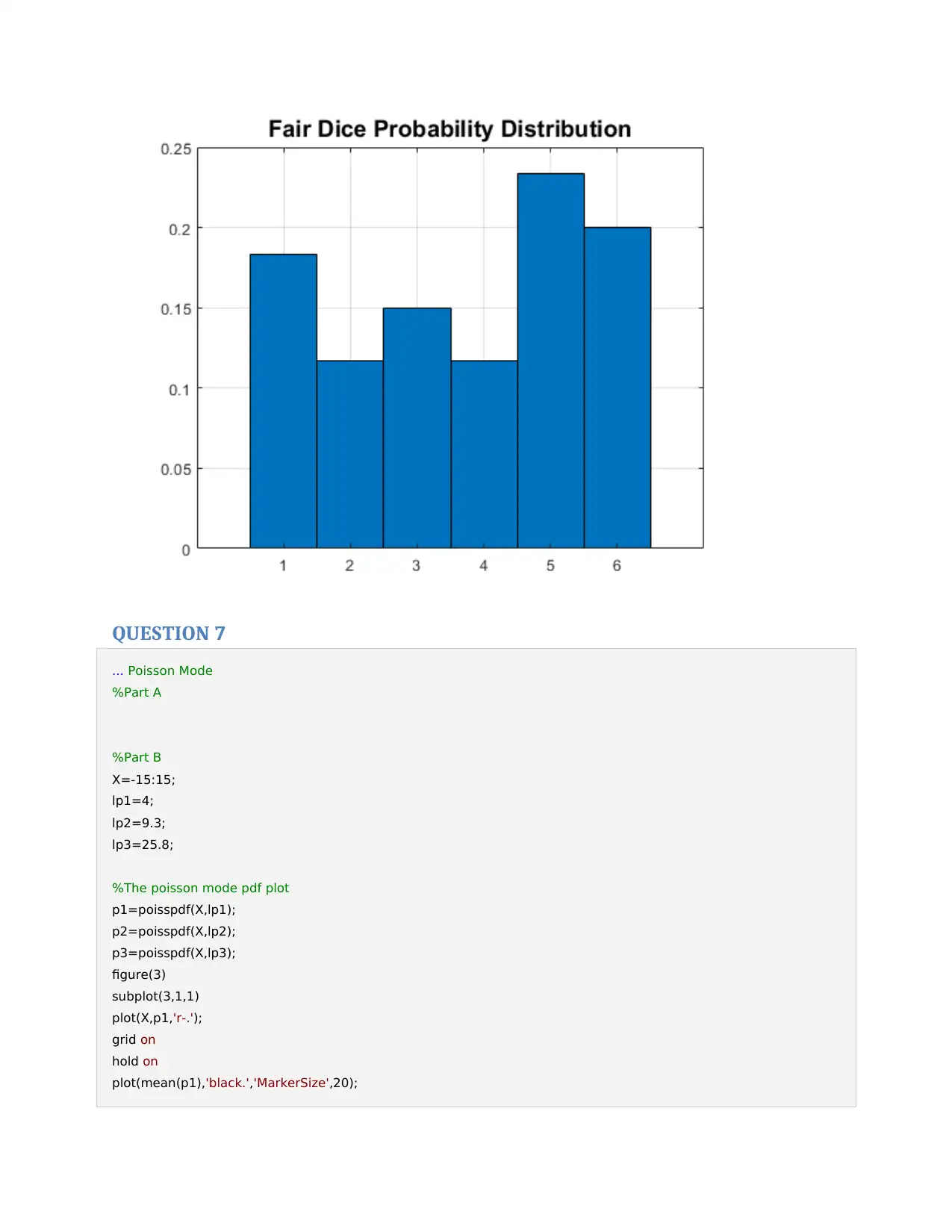
QUESTION 7
... Poisson Mode
%Part A
%Part B
X=-15:15;
lp1=4;
lp2=9.3;
lp3=25.8;
%The poisson mode pdf plot
p1=poisspdf(X,lp1);
p2=poisspdf(X,lp2);
p3=poisspdf(X,lp3);
figure(3)
subplot(3,1,1)
plot(X,p1,'r-.');
grid on
hold on
plot(mean(p1),'black.','MarkerSize',20);
... Poisson Mode
%Part A
%Part B
X=-15:15;
lp1=4;
lp2=9.3;
lp3=25.8;
%The poisson mode pdf plot
p1=poisspdf(X,lp1);
p2=poisspdf(X,lp2);
p3=poisspdf(X,lp3);
figure(3)
subplot(3,1,1)
plot(X,p1,'r-.');
grid on
hold on
plot(mean(p1),'black.','MarkerSize',20);
⊘ This is a preview!⊘
Do you want full access?
Subscribe today to unlock all pages.

Trusted by 1+ million students worldwide
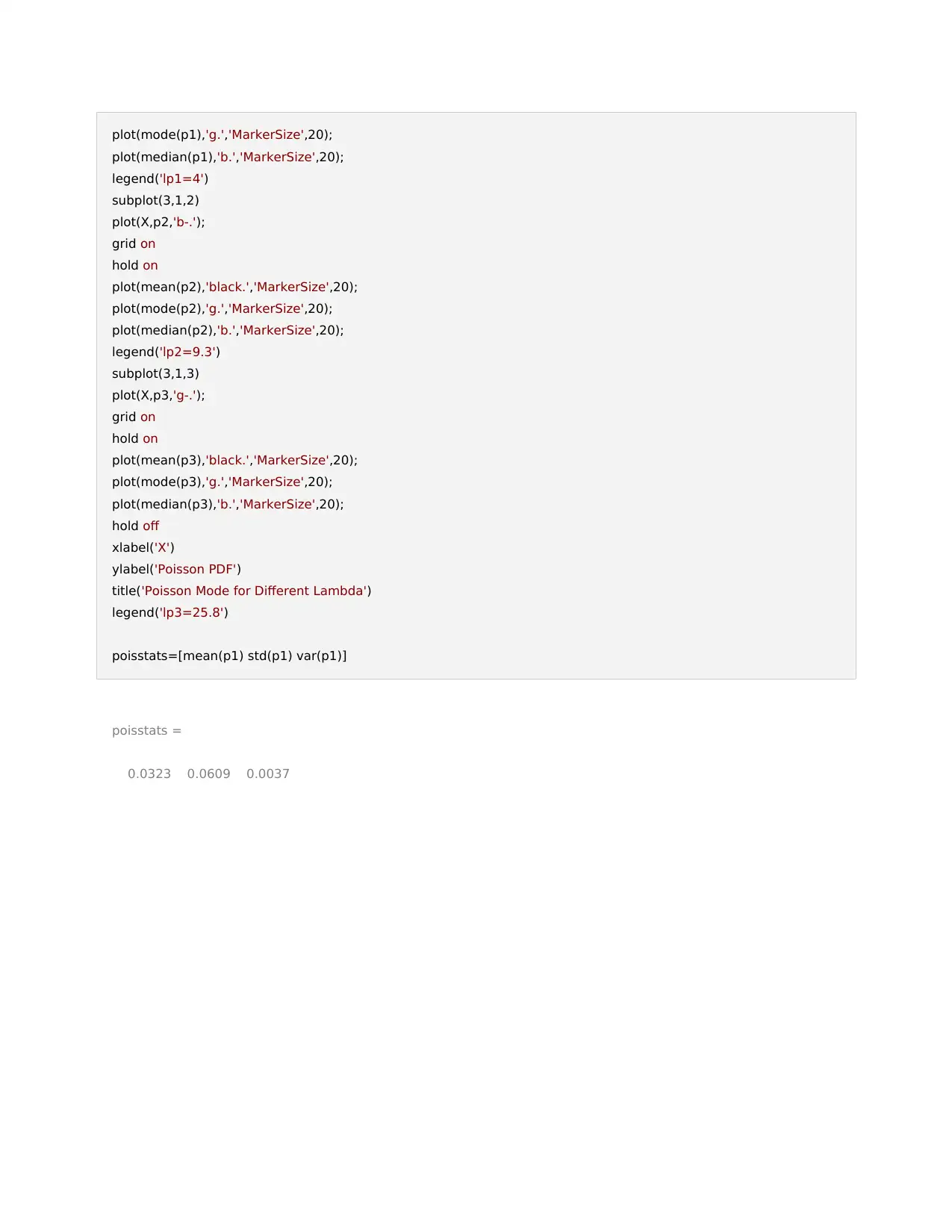
plot(mode(p1),'g.','MarkerSize',20);
plot(median(p1),'b.','MarkerSize',20);
legend('lp1=4')
subplot(3,1,2)
plot(X,p2,'b-.');
grid on
hold on
plot(mean(p2),'black.','MarkerSize',20);
plot(mode(p2),'g.','MarkerSize',20);
plot(median(p2),'b.','MarkerSize',20);
legend('lp2=9.3')
subplot(3,1,3)
plot(X,p3,'g-.');
grid on
hold on
plot(mean(p3),'black.','MarkerSize',20);
plot(mode(p3),'g.','MarkerSize',20);
plot(median(p3),'b.','MarkerSize',20);
hold off
xlabel('X')
ylabel('Poisson PDF')
title('Poisson Mode for Different Lambda')
legend('lp3=25.8')
poisstats=[mean(p1) std(p1) var(p1)]
poisstats =
0.0323 0.0609 0.0037
plot(median(p1),'b.','MarkerSize',20);
legend('lp1=4')
subplot(3,1,2)
plot(X,p2,'b-.');
grid on
hold on
plot(mean(p2),'black.','MarkerSize',20);
plot(mode(p2),'g.','MarkerSize',20);
plot(median(p2),'b.','MarkerSize',20);
legend('lp2=9.3')
subplot(3,1,3)
plot(X,p3,'g-.');
grid on
hold on
plot(mean(p3),'black.','MarkerSize',20);
plot(mode(p3),'g.','MarkerSize',20);
plot(median(p3),'b.','MarkerSize',20);
hold off
xlabel('X')
ylabel('Poisson PDF')
title('Poisson Mode for Different Lambda')
legend('lp3=25.8')
poisstats=[mean(p1) std(p1) var(p1)]
poisstats =
0.0323 0.0609 0.0037
Paraphrase This Document
Need a fresh take? Get an instant paraphrase of this document with our AI Paraphraser
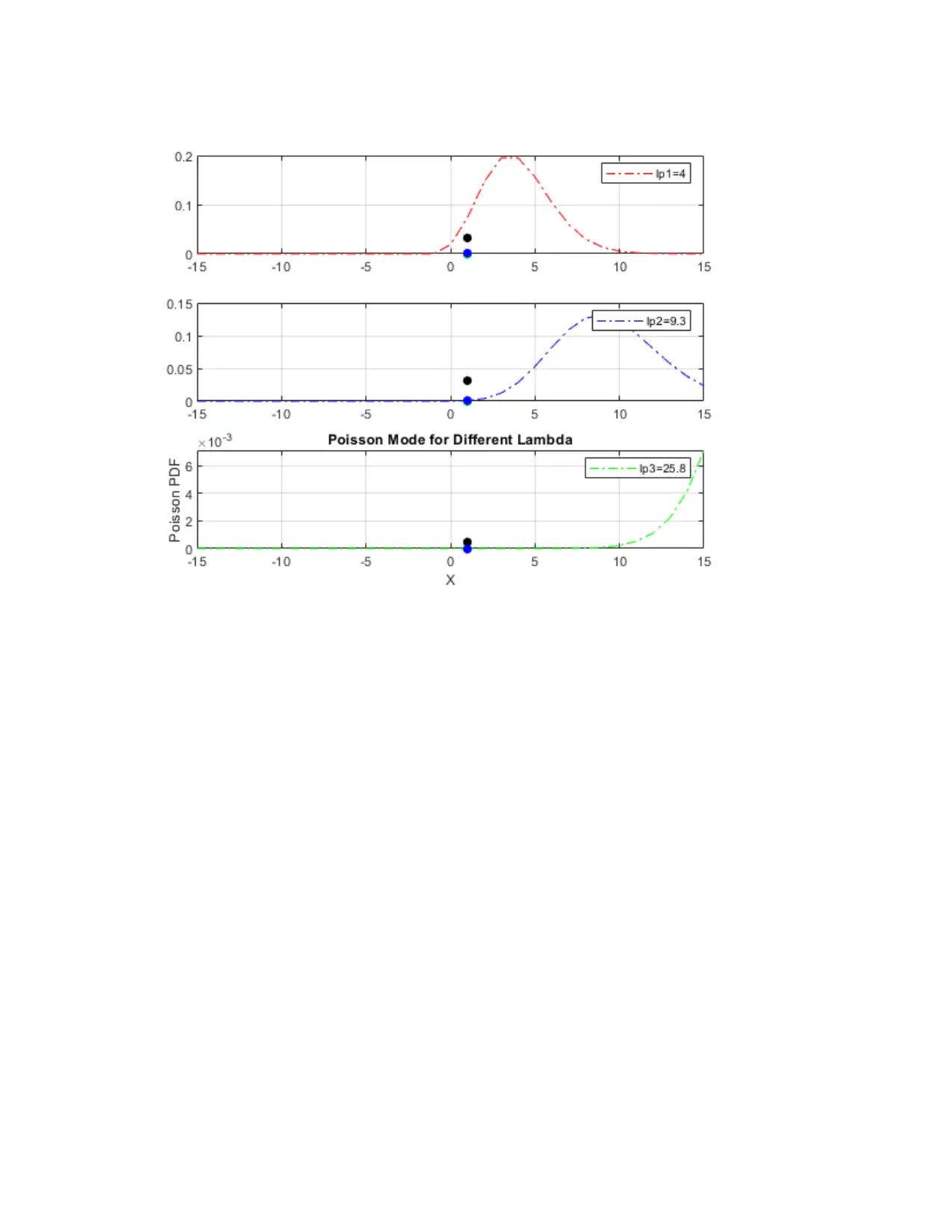
1 out of 8
Your All-in-One AI-Powered Toolkit for Academic Success.
+13062052269
info@desklib.com
Available 24*7 on WhatsApp / Email
![[object Object]](/_next/static/media/star-bottom.7253800d.svg)
Unlock your academic potential
Copyright © 2020–2025 A2Z Services. All Rights Reserved. Developed and managed by ZUCOL.
